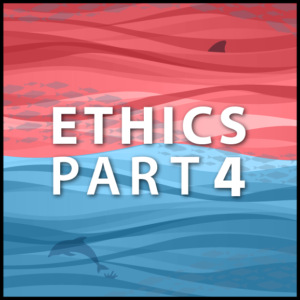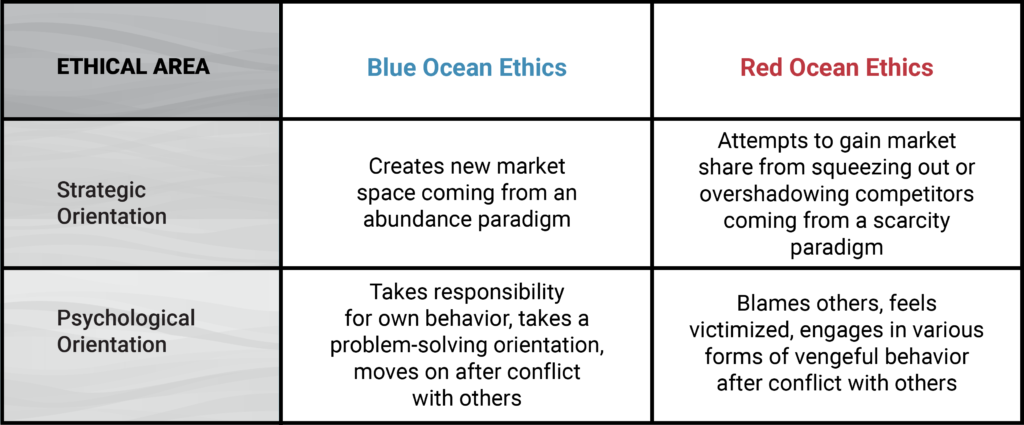An Enneagram in Business (EIBN) requirement is that all network members adhere to Blue Ocean ethics in order to maintain integrity and build trust among one another and with clients. These ethical guidelines, which I created, include the accurate representation of background and services; respect for intellectual property; open information and idea sharing; fair pricing; honoring agreements; an abundance rather than scarcity orientation; and respect for clients, collaborators and competitors.
Red Ocean Ethics: Individuals who use Red Ocean guidelines beat the competition using existing rules of competition and trading off between diversification (differentiation) of products, services, and cost.
Blue Ocean Ethics: Individuals who use Blue Ocean guidelines leverage untapped market space, expand existing industry boundaries, and/or move outside existing industry boundaries. The translation of Blue Ocean guidelines from organizational use to individual practice has 10 areas; this blog reviews two more of the 10, with earlier blogs having covered six topics and the remaining blogs to cover two additional areas. Thus far, values related to professional self-presentation, intellectual property, sharing of information, competitive orientation, and pricing and financial values have all been described. Now, the focus is strategic and psychological orientation.
Pricing
Strategic Orientation
The Blue Ocean position regarding strategic orientation is also a life position. Do you believe there is abundance in the world, enough to go around of what you need? That is the Blue Ocean. Or do you function from a scarcity paradigm, where there is a zero sum available in almost all circumstances. In other words, in the Red Ocean, one must be a shark because either “I win and you lose” or “ You win and I lose.” In the Red Ocean, there is no “We both win.”
Blue Ocean strategy goes further than paradigms or mental models. There are concrete actions behind Blue Ocean strategy. Essentially, there is no need to compete with others for market space. In the Blue Ocean, you seek customers who don’t use your products or services in their current form; you find ways to reach these customers using innovative platforms; you adjust your offerings to appeal to them; you assess how you operate, refine your ways of doing things, lower your costs, and add more value to your current and potential customers. In other words, you look ahead.
If you are operating in the Red Ocean, you look behind you and to the side to determine what everyone else is doing. You copy the work of others; for example, you use their business name, the titles of their offerings, the format of their materials. Rather than innovate creatively, you replicate. And if you get found out, you shrug your shoulders as if to say, “I don’t care” and “Why not!”
Why be Red when you can be Blue?
With the Enneagram, there is so much possibility, so many different applications, so many people who need and can use the system in their personal and professional lives. So why not be Blue Ocean? First, most organizations and most people operate in the Red Ocean. Perhaps people don’t know better and operate from this older paradigm.
Second, some consultants and trainers are not currently or don’t know how to be creative and innovative, particularly in the context of customer desires. To be Blue Ocean also requires both a vision into the future in terms of what will be wanted, combined with an ability to tune into customer trends at a group rather than individual level. Blue Ocean also requires a strategic and tactical orientation to adding value through what is offered to whom and in what manner, while also being conscious about how to streamline operations and reduce operational costs. Not everyone has the ability or experience to be visionary in this practical way, to attune to customer needs, and to run a business in a streamlined, cost effective way. Enneagram professionals may not have the background to operate in the Blue Ocean. But, it can be learned!
Psychological Orientation
In the Blue Ocean, Enneagram trainers, coaches and consultants take responsibility for own behavior, take a problem-solving orientation, and move on after conflict with others. When functioning in the Red Ocean, Enneagram professionals blame others, feel victimized, and engage in various forms of vengeful behavior after conflict with others. This can include passive-aggressive as well as directly aggressive behavior.
Blue Ocean psychological attitudes and behavior are the opposite. Blue Ocean psychological functioning is aligned with the higher levels of Emotional and Social Intelligence, which can also be thought of as higher levels of self-mastery or levels of development. This is what the Enneagram, in my view, strives to help people achieve. But do all Enneagram professionals act in a Blue Ocean manner? My experience is that many do and many do not. My guess is that most Enneagram professionals believe that they do. And why would someone think they are operating in the Blue Ocean, yet are not? Here are two reasons:
I teach, therefore I am!
Because people teach the Enneagram or work with it professionally, they believe that knowing the Enneagram means they are already highly developed and not really in need of further development work. Or, if they are working with the spiritual aspects of the Enneagram, they don’t think they need to work on the psychological level. This is also known as “spiritual bypass.” I actually heard an Enneagram author of some note say this in an IEA conference. And I have seen Enneagram professionals act in Red Ocean ways toward one another, except perhaps with those to whom they are close professionally or personally.
Projection
Some Enneagram professionals project their own ambition, competitiveness, self-oriented motivations, and more onto other Enneagram professionals. Often, this projection comes from insecurity and fear. They will see themselves as “good,” and those whom threaten them in some way as “bad.” And how they see these others as bad is more often than not a projection of themselves.
As an example, there are many times that people within the Enneagram community threaten to sue one another over what are, in my view, not really issues or not big issues worth suing over. These are often people who use the work of others without attribution. As another example, when the Enneagram in Business Network (EIBN) was doing research for the Best Practices Benchmark Report (2011), one Enneagram author and business consultant chose to not participate (which is this person’s right), but did so with accusations that the only reason we were doing this study – which took hundreds of hours and was published broadly to anyone interested in six languages – was to promote the EIBN. In fact, we conducted the benchmark study because we wanted to know the answers to why and how companies were currently using the Enneagram with success. In addition, we shared what we found with anyone who wanted the information because this was our intention. And no matter how many people told this Enneagram business consultant what the truth was, this person was sure, and likely still is, we were lying. All this is very Red Ocean.
Blue Ocean Summary
There is more than enough to go around if you have a Blue Ocean mind-set. There are enough people, companies, and not-for profits who want or will want to learn and use the Enneagram in organizations. If you operate in the Blue Ocean, this will happen, providing you have something of value to offer. If you operate in the Red Ocean, you’ll see colleagues as competitors, you’ll be looking around to see who might “steal” your information rather than creating new ideas yourself. You’ll be boasting and making offers to clients that you can’t deliver on effectively and then come up empty handed. For these reasons and many others, it is better to be a dolphin in the Blue Ocean than a shark swimming in the Red Ocean.
Ginger Lapid-Bogda PhD, the author of seven Enneagram-business books, is a speaker, consultant, trainer, and coach. She provides certification programs and training tools for business professionals around the world who want to bring the Enneagram into organizations with high-impact business applications, and is past-president of the International Enneagram Association. Visit: TheEnneagramInBusiness.com | ginger@theenneagraminbusiness.com



Comments are closed.